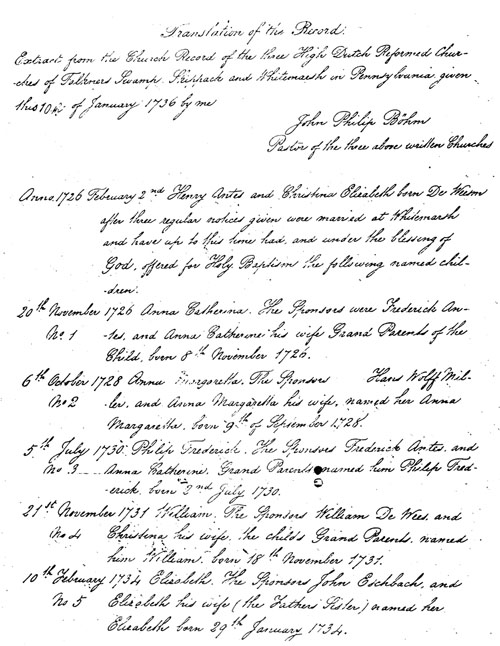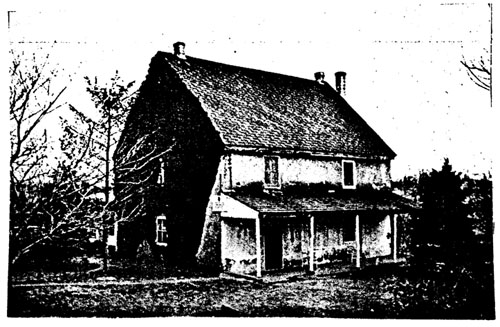|
Home : Quarterly Archives : Volume 31 |
Tredyffrin Easttown Historical Society |
|
Source: April 1993 Volume 31 Number 2, Pages 77–82 Henry Antes When the History Club visited the Peter Wentz Farmstead in August last year, in the introductory slide presentation it was noted that in the fall of 1777, before General Washington made the Wentz home his headquarters, his headquarters were at Pennypacker's Mills. "At that time," it was further noted, "he was undoubtedly welcomed into many of the area's grander houses, such as the home of Henry Antes, where it is said that a number of his officers were quartered." It happens that one of our Club members, my husband Richardson Latrobe Onderdonk, is a descendant of this Henry Antes, through the marriage of Antes' daughter, Anna Margaretta Antes, to the Rev. Benjamin Latrobe in England. Talbot Hamlin, in his 1955 biography of Latrobe, describes Benjamin Henry Latrobe's mother's family. Anna Margaretta Antes was born in Pennsylvania on September 9, 1728, the second of eleven children born to Henry Antes and his wife Christina Elisabeth DeWees. Henry Antes, who became a religious leader among the German-Americans in Pennsylvania, emigrated to America with his parents, Philip Frederick and Anna Catherine Antes, from Freinsheim in the Rhenish Palatinate when Henry was about nineteen years of age. Hamlin states that Philip Frederick's father (Anna Margaretta's great-grandfather) was originally Baron Von Blume, an abbot of a monastery who, somehow, converted to Protestantism, married an abbess similarly converted and together they fled from Germany to the tolerance of Pennsylvania, where they started a new life, taking the name of Anthos (a translation of the German "Blume" into the Greek word for flower), later simplified to Antes.
Part of a translated extract from the Church Records of the High Dutch Reformed Churches of Falkner Swamp, Skippack, and Whitemarsh recording the marriage of Henry Antes and Christina Elisabeth DeWees and the birth of their daughter, Anna Margaretta In the Dictionary of American Biography it is stated that "an ancestor" of Philip Frederick, Baron Von Blume from Mainz, had hellenized his German name into its Greek equivalent Antes in order to escape persecution during the Thirty Years' War (1618-1648), this some 75 or 80 years before an Antes came to America. And in the Genealogy of Henry Onderdonk, written in about 1870 and framed in glass, now in my husband's possession, it is stated: "John Frederick Antes was born Baron Von Blume, head of a noble family of the German Palatinate. He took to a monastic life and changed his name to the Greek equivalent -- anthos -- a flower -- corrupted since into Antes. He became a protestant, and to escape persecution came to this country, married, and settled in Pennsylvania. It is not possible for me to reconcile these three statements! But I have learned a good deal about Henry Antes. He is described as a wealthy landowner, tall and powerfully built, possessing the versatile gifts required of a pioneer who is to succeed. His place, historically, is based upon his religious leadership and spiritual enlightenment. At first he was a member of the Reformed Church at Falkner Swamp, and later, with several others, he formed a group called the Associated Brethren of Skippack, seeking religious unity. He was an ally of the great Moravian leader Count Zinzindorf, and when Zinzindorf returned to Europe in 1743 Antes sent his fourteen-year old daughter, Anna Margaretta, to be educated in the Moravian schools in England. She later became a teacher, and then headmistress, of the Moravian School for Girls in London. When the school was moved to Fulneck, the British educational center of the Moravian movement, in East Riding of Yorkshire, her path crossed that of the brilliant preacher and administrator, the Reverend Benjamin Latrobe, the head of the school. Not long afterwards they married. Their son, born May 1, 1764, when the mother was 36 and the father 38, was Benjamin Hnery Latrobe, the future great architect in the United States from 1795 to 1820. [*] (It was through his mother that Benjamin Henry Latrobe received large land holdings in Pennsylvania, as his share of the Antes wealth.) To return to Henry Antes: Acting as agent for the Moravian church, Antes bought a tract of land along the Lehigh River measuring some 500 acres, for the price of £400, This purchase provided the nucleus of what was to become the town of Bethlehem. He moved from his home in Frederick township to the new town and served as trustee of Moravian property in Philadelphia, acting as their agent in all things. As their business manager, he built a mill and other works. When the Moravians were attacked, he defended them. When the governor appointed him a justice of the peace, in this capacity he investigated the grievances of the Indians. In 1750 Antes left Bathlehem and the Moravians and returned to Frederick township, although he continued to be active in Moravian affairs. In 1752-53, with others, he explored an area in North Carolina near the Yadkin River, purchasing 100,000 acres of land which were to become the Moravian colony of Wachovia. He died in his home in Frederick in 1755, leaving a legacy to the Moravians. Four of his sons survived. Frederick (1730-1801), a Revolutionary War hero, was active in state and local politics, and later worked with Benjamin Henry Latrobe in the Susquehana River improvement project in 1801. William (1731-1810), a gunsmith and local politician in Philadelphia and Northumberland counties, moved in 1795 to the Genesee country in New York. Henry (1736-1820), a Revolutionary War veteran, served as sheriff of Northumberland County. John (1740-1811), a jeweller and watchmaker, was for a time a Moravian missionary in Egypt, and eventually settled in Fulneck in England. Presumably, Benjamin Henry Latrobe did not meet his Antes relatives much before 1798. An entry in his Richmond, Virginia journal for September 30, 1797 notes: "One of my very good friends and relations in Pennsylvania sent me as a token of their remembrance a young bear caught upon my own land on resurveying it." [p. 302] And he often referred to his very near and numerous relations in Pennsylvania, the Antes family, in April 1798, from Philadelphia, he wrote to his Uncle Henry, introducing himself and expressing his hope for a personal acquaintance. Indeed, he counted himself an American by virtue of his American grandfather: "My family for more than 90 years," he wrote, "have been settled in Pennsylvania and although I was educated in Europe, on the continent, and for some years practiced my profession in England, I am already an American of the fourth generation." [ibid., vol. I, p. xxii] Latrobe's journal for September 1801 includes notes from his Field Book and Accounts for the period of August to September 1801, while making a survey of the Susquehanna. He notes a series of occurrences respecting his uncle, Colonel Frederick Antes, who worked with him on the survey and was buried in Lancaster on September 21, 1801 after a brief illness. And it is here that these researches end. TopAddendum The Henry Antes House, built in 1735, was entered onto the Pennsylvania Register of Historic Sites and Landmarks in Harrisburg in August 1970. Twenty-two years later, largely through the efforts of Tim Noble, chairman of the Antes House Restoration Committee of the Goschenhoppen Historians, Inc., the Homestead also received national landmark status. For a number of years the Goschenhoppen Historians had paid the insurance on the neglected property, owned by the Girl Scout Council of Philadelphia, and in 1986 they were able to purchase the house and one acre of land from the Council. In June 1991 they applied for a $200,000 Pew Charitable Matching Grant, which requires them, over a period of three years, to come up with the sum of $40,000.
The Henry Antes House in 1960 As of January of this year they had obtained $14,000 in money, materials, and labor toward meeting this figure, and are sanguine that they will be successful in obtaining the grant. Over the past six years the Historians have stabilized the oak beams in the cellar, provided for drainage in the cellar, and installed a dehumidifier. The Homestead is also now protected by a security system. (It was rewarding to me to visit the Homestead last May and note the improvements to the building, as well as the maintenance of the land.) The Goschenhoppen Historians, Inc. was chartered in 1964, its name possibly derived from the Delaware Indians, or possibly attributable to the Biblical Land o' Goshen. In Red Men's Hall in Green Lane they maintain a Country Store and Folk-Life Museum, open on Sunday afternoons from April through November or upon special request, and sponsor a two-day Folk Festival on the second Friday and Saturday in August in Goschenhoppen Park in East Greeneville. All visitors are heartily welcome. Mr. Norman Hoffman of the Goschenhoppen Historians, Inc. very kindly provided this information on the telephone, and shared his enthusiasm for the remarkable person Henry Antes (1701-1755) was. He cited, as an example of Henry Antes' technical ability as an architect and builder, the latter's creating a water vapor barrier to insulate the floor between/over the cellar and its ceiling. Mr. Hoffman described Henry Antes as a man gifted in hand, mind, and muscle, as well as a just and enlightened seeker of universal brotherhood. He was a leader of men. In addition, Hoffman noted that the Groschenhoppen Historians' application to the Pew Trust documents the tracing of the deeds to the property. Donations toward the restoration of the Henry Antes House can be sent to Mr. Norman Hoffman, Treasurer, Antes House Restoration Committee, 172 Stone Road, Barto, PA 19504-9329. Further information concerning the Antes House Restoration and the work of the Goschenhoppen Historians may also be obtained from Tim Noble, Chairman, Antes House Restoration Committee, Log House Road, Box 124 RD 1, Zionsville, PA 18092 (day phone (215) 679-5110). TopSources Antes Family FOCUS, Vol. 2, No. 1, October 1970 Carter, Edward C. II;[ed.] : The Virginia Journals of Benjamin Henry Latrobe 1795-1798, Volumes I and II. Yale University Press, New Haven and London 1977. Published for the Maryland Historical Society Carter, Edward C. II; Van Home, John C; and Fornwalt, Len W. [eds.] The Journals of Benjamin Henry Latrobe 1799-1820 from Philadelphia to New Orleans, Volume 3. Yale University Press, New Haven and London 1980. Published for the Maryland Historical Society Hamlin, Talbot : Benjamin Henry Latrobe. Oxford University Press, New York 1955 Johnson, Allen [ed.] : Dictionary of American Biography. Charles Scribners, New York 1957 Genealogy of Henry Onderdonk [mss] * See Benjamin Henry Latrobe" in the January 1987 [Vol. XXV, No. 1] issue. |

